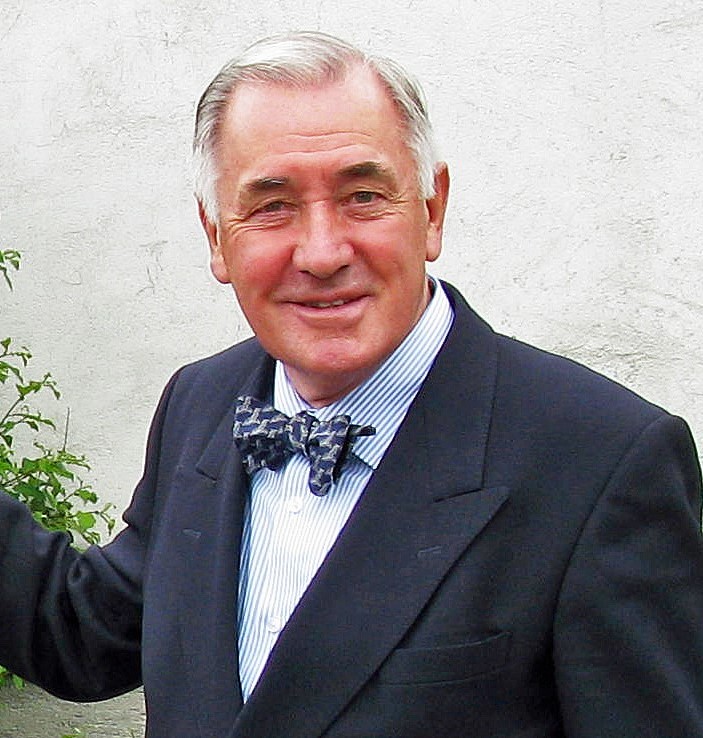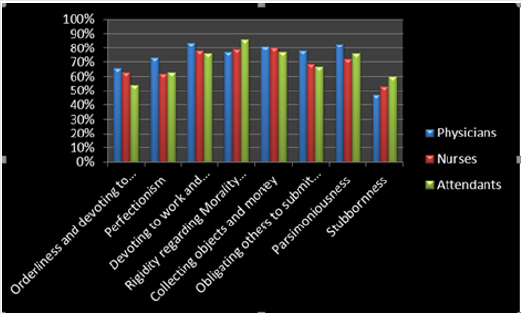
Lupine Publishers Group
Lupine Publishers
Menu
ISSN: 2638-6062
Research Article(ISSN: 2638-6062) 
Experimental Appraisal of Social Darwinism By Way of Temperament and Personality Volume 3 - Issue 5
Saeed Shoja Shafti MD*
- Full Professor of Psychiatry, University of Social Welfare and Rehabilitation Sciences, Iran
Received: October 21, 2019; Published: October 30, 2019
*Corresponding author:Saeed Shoja Shafti MD, Full Professor of Psychiatry, University of Social Welfare and Rehabilitation Sciences, Iran
DOI: 10.32474/PRJFGS.2019.03.000173
Abstract
Introduction: In line with some studies, obsessive-compulsive traits, as possible behavioral biomarkers of socio-cultural evolution, could have vital role in achievement of valuable goals. In the present assessment, frequency of such characters has been investigated in three different groups of professions: physicians, nurses and servants.
Method and Material: Consistent with an introspective, single-blind design, 35 physicians, 49 nurses and 43 attendants, as accessible samples, among total personnel of a general hospital, who had been selected randomly, had been questioned by means of a nameless, self-reply questionnaire as regards the existence of obsessive-compulsive traits in themselves. Data were analyzed by comparison of proportions.
Results: According to the findings, no significant difference was evident between the aforementioned groups of personnel respecting prevalence of obsessive-compulsive traits, whether individually (any specific trait) or as a group (individuals with at least four traits).
Conclusion: Obsessive-compulsive traits, as possible behavioral biomarkers of socio-cultural evolution and tools of success, have a comparable distribution in all social classes and different group of workers.
Keywords: Obsessive-compulsive personality trait; Social Darwinism; Evolutionary psychology
Introduction
Social Darwinism believes that human groups and races are
subject to the same laws of natural selection as Charles Darwin
had perceived in plants and animals in nature. According to the
theory, which was popular in the late 19th and early 20th centuries,
the weak were lessened and their cultures restricted whereas the
strong grew in power and in cultural influence over the weak [1].
Social Darwinists believed that the life of humans in society was
a struggle for existence governed by “survival of the fittest,” a
phrase proposed by the British scientist and philosopher Herbert
Spencer. The social Darwinists-particularly Spencer and Walter
Bagehot in England and William Graham Sumner in the United
States-supposed that the process of natural selection acting on
variations in the population would result in the survival of the best
competitors and in continuing perfection in the people. So, societies
were regarded as organisms that evolve in this mode. Consequently,
class stratification was justified on the basis of “natural” inequalities
among individuals, for the control of property and was said to
be a correlate of superior and inherent moral attributes such as
temperance, frugality and industriousness [1]. Attempts to reform
society through state intervention or other means would, therefore,
interfere with natural processes; unrestricted competition and
defense of the existing state of affairs, which were in accord with
biological selection. The poor were the “unfit” and should not be
aided; Also, in the struggle for survival, wealth was a sign of success.
At the societal level, social Darwinism was used as a philosophical
rationalization for imperialist, colonialist, and racist policies,
sustaining belief in Anglo-Saxon or Aryan cultural and biological
superiority [1].
According to Michael Ruse, Darwin had read Malthus’ famous
“Essay on a Principle of Population” in 1838, four years after
Malthus’ decease. Malthus himself anticipated the social Darwinists
in suggesting that charity could worsen social complications [2].
Another of these social interpretations of Darwin’s biological views,
later known as eugenics, was put forth by Darwin’s cousin, Francis Galton, in 1865 and 1869. Galton maintained that just as physical
characters were clearly inherited among generations of people,
the same could be said for mental abilities (genius and talent).
Galton claimed that social moralities needed to change so that
heredity was a conscious decision in order to avoid both the overbreeding
by less fit members of society, and the under-breeding
of the more fit ones [3]. The simpler aspects of social Darwinism
followed the earlier Malthusian ideas that humans, especially
males, require competition in their lives in order to survive in the
future. In addition, the poor should have to provide for themselves
and not be given any assistance. However, in the midst of this
environment, most social Darwinists of the early twentieth century
in reality supported better working circumstances and incomes.
Such measures would grant the poor a better chance to provide
for themselves yet still distinguish those who are capable of
succeeding from those who are poor out of weakness, laziness, or
inferiority [2]. On the other hand, according to a theory, which was
grounded on methodical studies and sociobiological philosophy
(Neo-Darwinism), obsessive-compulsive traits [4] (Table 1),
as possible accelerator of socio-cultural evolution and success,
was meaningfully more prevalent among successful people in
comparison with unsuccessful individuals [5-7]. While there are
scholars, as well, who are not agreeing with such a suggestion [8],
the same implication has been assumed by other scholars, too [9-
15]. So, maybe they could be accounted, in general, as some kind
of behavioral biomarker designed for attainment of productive
activities or objectives. But is it possible to consider them, as well,
as dynamic biomarkers for rationalization of social stratification
and classification? In other words, are obsessive-compulsive traits
the primary reason of development and achievement of social
position, disregard to other socio-economic factors? Hence, in
the present evaluation, prevalence of this group of characters has
been compared among three groups of staffs (physicians, nurses
and attendants) to see that is there, in essence, any substantial
difference among them with respect to the aforesaid behavioral
biomarker.
Method and Material
A private general hospital in north of capital city of Tehran (Iran Mehr Hospital), had been selected as the field of study in the present assessment. For evaluation, 35 physicians, 49 nurses and 43 attendants, as accessible samples, among total personnel of hospital (n=531), who had been chosen randomly, had been questioned, incognito, by means of a nameless, self-reply questionnaire as regards the existence of obsessive-compulsive traits in themselves. Randomization was based on nonspecific selection of existent staff in different districts of hospital, including internal, surgical and pediatric ward, as well as critical care units, in the same shift of functioning (afternoon and night). The study had been accomplished according to a single-blind plan; while the evaluator (an associate psychiatrist) was aware regarding the proposal, the samples were blind as regards the objectives of the assessment. Clinical diagnosis, as well, was in essence based on ‘Diagnostic and Statistical Manual of Mental Disorders, 5th edition (DSM-5)’ [4].
Statistical Analysis
Analysis of dependent variables had been accomplished by ‘t-test’ and assessment of independent variables had been explored by means of ‘comparison of proportions’. Statistical significance, as well, had been defined as a p value ≤0.05. MedCalc Statistical Software version 15.2 was used as statistical software tool for analysis.
Results
Demographic characteristics of participants have been shown in Table 2. In spite of randomized process of sample selection, conclusions revealed that there was no significant difference with respect to quantity, age and duration of occupation amongst the aforesaid groups. On behalf of simplicity, in the current tables (Tables 2-4), only analytic parameters that primarily belong to comparison between highest and lowest points (mean, number, or percentage) have been displayed. Anyhow, outcome of the present estimation has revealed that, while, apparently, there was an unequal distribution of traits in favor of one of the professions (physicians), there was, in essence, no significant difference concerning ‘orderliness and devoting to details’, ‘perfectionism’, ‘devoting to work and avoiding leisure’, ‘rigidity regarding morality and ethics’, ‘collecting objects and money’, ‘obligating others to submit his or her style of behavior’, ‘parsimoniousness’, and finally ‘stubbornness’ among the aforementioned groups (Table 3) (Figure 1). Also, with regard to presence of at least four traits in any person, which could put forward the symbolic or possible diagnosis of obsessive - compulsive disorder (OCPD), along with DSM-5, over again, no significant difference was evident among them (Table 4). ‘Devoting to work and avoiding leisure’, ‘Collecting objects and money’ and ‘Rigidity regarding morality and ethics’ were the most prevalent traits among physicians, nurses, and attendants, respectively.
Table 4: Percentages of personnel with at least four obsessive-compulsive traits. (Possible obsessive–compulsive personality disorder)

Discussion
Social Darwinism is any of various theories of society which emerged in the United Kingdom, North America, and Western Europe in the 1870s, claiming to apply biological impressions of natural selection and survival of the fittest to politics and sociology. Social Darwinists claim that the strong should see their wealth and power increase, whereas the weak should see their wealth and power decrease [16]. Different Social-Darwinist groups have differing opinions about which groups of individuals are considered to be the strong and which groups of persons are considered to be the weak, and they also hold different attitudes regarding the precise mechanisms that should be used to reward strength and punish weakness [17]. On the other hand, Social Darwinism has many definitions, and some of them are discordant with each other. Accordingly, Social Darwinism has been criticized for being an inconsistent philosophy, which does not lead to any flawless political assumptions. For example, ‘The Concise Oxford Dictionary of Politics’ states: Part of the difficulty in establishing sensible and consistent usage is that commitment to the biology of natural selection and to ‘survival of the fittest’ entailed nothing uniform either for sociological method or for political doctrine. A ‘social Darwinist’ could just as well be a defender of laissez-faire as a protector of state socialism, just as much an imperialist as a domestic eugenist [18]. Concerning the aforesaid characters, it should be mentioned that the terms ‘obsessive character’ and ‘obsessive personality’ are more inclusive, subsuming both clinical and non-clinical exhibitions of the pattern [19]. As said by some scholars, obsessive-compulsive disorder is highly heritable and not ominously influenced by “common, shared-infamily’s environmental factors” [19]. Then again, truly integrating heritability estimates into a functional etiological account of obsessive character comes from an evolutionary model that understands obsessive personality to be an evolved strategy rather than a dysfunctional disorder [19].
As a result, ‘obsessive character’ or ‘obsessive personality’ is generally substituted for ‘Obsessive Compulsive Personality Disorder’ because the latter is a smaller subset of the former [19]. Back to our discussion and according to the results, the present assessment could not prove any meaningful difference as regards obsessive-compulsive traits amongst physicians, nurses, and attendants. Such an outcome is somewhat in harmony with the believes of Kropotkin, who debated that Darwin did not describe the fittest as the strongest, or cleverest, but acknowledged that the fittest could be those who cooperated with each other and in many animal societies struggle is replaced by co-operation [20]. Also, our conclusion is somewhat in harmony with Becquemont, who indicated that what we still call ‘Social Darwinism’ is the result of a misinterpretation: the theories stated under that phrase have little to do with the Darwinian notions of natural selection or descent with modification. They have their origin in a pre- Darwinian conception of the struggle for survival, which Darwin had used in a metaphorical sense. This confusion will then appear to refer clearly to the relationship we establish between society and biology, whether biological laws are directly prolonged in society, or relatively amalgamate in a close network [21]. Despite that fact that the scientific contribution of Darwin has now been acknowledged by scientists from various disciplines, in recent years, several evolutionists have criticized Darwin as outdated, arguing that ‘Darwinism,’ assimilated to the ‘tree of life,’ cannot explain microbial evolution, or else was not operating in early life evolution [22]. Society is a complex interrelated network of human beings, who are working, in an organized manner, for supporting, management and survival of the general public. Socio-economical progression in society is not a linear process and may encounter a lot of obstacles. A variety of issues like social class, cultural values, economic power, intelligent capabilities, communicative skills, individual characteristics, surroundings’ assets or deficits, availability or deficiency of educational facilities, societal supporting systems, and medical and mental health programs and services, in addition to personality traits, can have decisive impact on final achievement of any individual.
Currently, we may find a lot of persons, who have achieved higher post-graduate levels many years after their primary lower under-graduate statuses and have moved from lower and simpler jobs to higher and more complicated careers. This is, as well, another evidence in favor of dynamics of social forces, and in opposite to presumed inertia of social Darwinism. Anyhow, over the last years, an increasing number of studies have revealed individual variances in a specific behavioral feature over time, between the same manners across different environmental conditions, or relations between different behavioral characters. While such investigations are indispensable for providing the material that will help us to generalize the existence of behavioral or personality patterns across the world, they are limited by their descriptive nature, and it is essential to transfer from this descriptive phase of personality studies to the experimental study of the ecological relevance and fitness consequences of personality variances [23,24]. In this regard, Reichborn-Kjennerud et al. has recommended against grouping obsessive personality within the anxious and fearful cluster C of personality disorders, for the reason that it is much more heritable and distinct from both the avoidant and dependent personalities. As Reichborn-Kjennerud et al. had stated, obsessive personality is truly ‘genotypically’ and ‘phenotypically’ distinct from its two counterparts, because the avoidant personality and the dependent personality are ‘related to the … higher-order factor’ of emotional dysregulation, while the obsessive personality is related to ‘the lower-order trait of compulsivity’ [25]. Small sample size, restriction of field of study to a private general hospital, lack of standardized scales or outcome measures, single-blind plan and self-reply method of questionnaire were among the weaknesses of the present study. Certainly, additional methodical surveys in future will help to deliver better answers for the abovementioned query.
Conclusion
Obsessive-compulsive traits, as possible behavioral biomarkers of socio-cultural evolution and tools of success, have a comparable distribution in all social classes and different group of workers.
References
- https://www.britannica.com/topic/social-Darwinism
- Diane PB (2003) The Cambridge Companion to Darwin. Cambridge. Cambridge University Press, p. 227.
- Lester WF (1907) "Social Darwinism". American Journal of Sociology 12: 709-710.
- (2013) American Psychiatric Association (APA) Diagnostic and Statistical Manual of Mental Disorders. (5th) Washington, DC: American Psychiatric Association,pp.678-682.
- Shoja Shafti S (2015) Experimental Appraisal of Obsessive-Compulsive Traits: An Evolutionary Inquiry in the Ground of Social Darwinism 1(1): 17-22.
- Shoja Shafti S (2019) Obsessive-Compulsive Traits, as Behavioral Invention & Foundation of Cultural-Historical Evolution: A Pilot Study. American Journal of Biomedical Science & Research 3(3):201-205.
- Shoja Shafti S (2019) A Pilot Study re Behavioral Root of Cultural-Historical Development: A Neo-Darwinian Stance. Online Journal of Neurology and Brain Disorders 2(4): 156-161.
- Soeteman DI, Hakkaartvan Roijen L, Verheul R, Busschbach JV (2008) The economic burden of personality disorders in mental health care. J Clin Psychiatry 69(2): 259-265.
- Barber JP, Morse JQ, Krakauer ID, Chittams J, Crits-Christoph K (1997) Change in obsessive-compulsive and avoidant personality disorders following time-limited supportive-expressive therapy. Psychotherapy 34(2): 133-143.
- Skodol AE, Gunderson JG, McGlashan TH, Dyck IR, Stout RL, et al. (2002) Functional impairment in patients with schizotypal, borderline, avoidant, or obsessive-compulsive personality disorder. Am J Psychiatry 159(2): 276-283.
- Aaronson CJ, Bender DS, Skodol AE, Gunderson JG (2006) Comparison of attachment styles in borderline personality disorder and obsessive-compulsive personality disorder. Psychiatr Q77(1): 69-80.
- McGlashan TH, Grilo CM, Skodol AE, Gunderson JG, Shea MT, et al. (2000) The collaborative longitudinal personality disorders study: Baseline axis I/II and II/II diagnostic co-occurrence. Acta Psychiatrica Scandinavica 102: 256-264.
- Jovev M, Jackson HJ (2004) Early maladaptive schemas in personality disordered individuals.J Pers Disord 18(5): 467-478.
- Ryder AG, Costa PT, Bagby RM (2007) Evaluation of the SCID-II personality disorder traits for DSM-IV: Coherence, discrimination, relations with general personality traits, and functional impairment. J Pers Disord 21(6): 626-637.
- Ullrich S, Farrington DP, Coid JW (2007) Dimensions of DSM-IV personality disorders and life-success. J Pers Disord 21(6): 657-663.
- Williams R (2000) "Social Darwinism". In John Offer (ed.) Herbert Spencer: Critical Assessment. London; New York: Routledge, pp.186-199.
- Claeys G (2000) The "Survival of the Fittest" and the Origins of Social Darwinism. Journal of the History of Ideas 61 (2):223-240.
- Leonard TC (2009) Origins of the Myth of Social Darwinism: The Ambiguous Legacy of Richard Hofstadter's Social Darwinism in American Thought. Journal of Economic Behavior & Organization 71(1):37-51.
- Hertler SC (2014) A Review and Critique of Obsessive-Compulsive Personality Disorder Etiologies: Reckoning with Heritability Estimates. Europe's Journal of Psychology 10(1): 168-184.
- Diane P (2006) "Darwin, social Darwinism and eugenics". In Hodge, Jonathan; Radick, Gregory (eds.) The Cambridge companion to Darwin. Cambridge: Cambridge University Press, p.230.
- Becquemont D (2011) Social Darwinism: from reality to myth and from myth to reality.Stud Hist Philos Biol Biomed Sci 42(1):12-1
- Forterre P (2012) Darwin's goldmine is still open: variation and selection run the world.Front Cell Infect Microbiol 2: 106.
- Bell AM (2007) Evolutionary biology: animal personalities. Nature 447(7144): 539-540.
- Cote J, Dreiss A, Clobert J (2008) Social personality traits and fitness. Proc. R. Soc. B 275: 2851–2858.
- ReichbornKjennerud T, Czajkowski N, Neale MC, Orstavik RE, TorgersenS, et al.(2007) Genetic and environmental influences on dimensional representations of DSM-IV cluster C personality disorders: A population-based multivariate twin study. Psychol Med 37(5): 645-653.

Top Editors
-

Mark E Smith
Bio chemistry
University of Texas Medical Branch, USA -

Lawrence A Presley
Department of Criminal Justice
Liberty University, USA -

Thomas W Miller
Department of Psychiatry
University of Kentucky, USA -

Gjumrakch Aliev
Department of Medicine
Gally International Biomedical Research & Consulting LLC, USA -

Christopher Bryant
Department of Urbanisation and Agricultural
Montreal university, USA -

Robert William Frare
Oral & Maxillofacial Pathology
New York University, USA -

Rudolph Modesto Navari
Gastroenterology and Hepatology
University of Alabama, UK -

Andrew Hague
Department of Medicine
Universities of Bradford, UK -

George Gregory Buttigieg
Maltese College of Obstetrics and Gynaecology, Europe -

Chen-Hsiung Yeh
Oncology
Circulogene Theranostics, England -
.png)
Emilio Bucio-Carrillo
Radiation Chemistry
National University of Mexico, USA -
.jpg)
Casey J Grenier
Analytical Chemistry
Wentworth Institute of Technology, USA -
Hany Atalah
Minimally Invasive Surgery
Mercer University school of Medicine, USA -

Abu-Hussein Muhamad
Pediatric Dentistry
University of Athens , Greece

The annual scholar awards from Lupine Publishers honor a selected number Read More...








